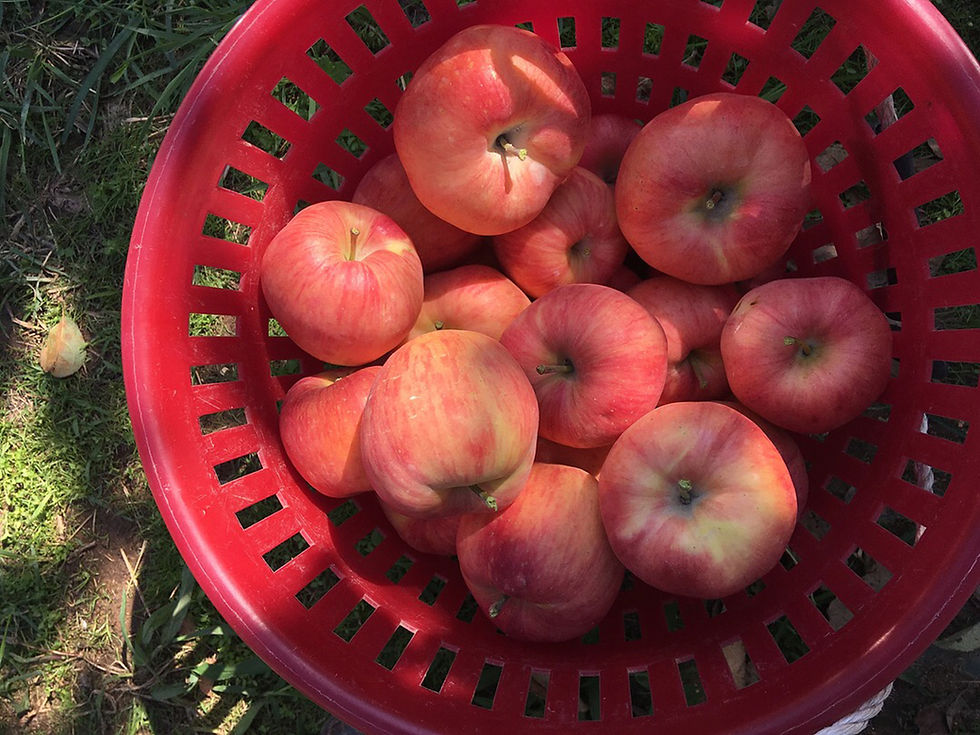
#19
DECEMBER 2021
食べることは、生きること。
生きることは、つくること。
つくることは、感じること。
感じることは、国境を越えること。
食・農・芸術・韓国を通して「人」を描きます。
これは6年前、地域情報紙の編集記者として働いていた会社を辞めた時、新しい名刺に書き添えた言葉だ。
肩書きは「半農半ライター」。30代後半からの人生は、半自給的な暮らしをしながら、食・農・芸術・韓国をテーマに、自分の体験や今を生きる人たちの姿を書いていきたい。そんな思いを込めて作った名刺だった。
半農半ライター

PEOPLE
STAY SALTY ...... people here
What are your dreams?
12.5 2021
あなたの夢は、何ですか?
Kim Mina

本当に望む暮らしとは?
それまでの私は、農業とは無縁の生活を送っていた。
片道2時間の通勤で、家には寝に帰るだけの毎日。
残業が続くと食事は不規則になり、いつも慢性的な肩こりや腰痛、逆流性食道炎に悩まされていた。
編集記者の仕事は、生みの苦しみが伴うとはいえ、とても楽しかった。
取材先や読者から、感謝やお褒めの言葉が届くことも増え、「もしかしてこの仕事が私の天職なのかも」と、ようやく自信が持てるようになってきた頃でもあった。
それなのに、もう一人の私がいつも首をかしげていたのだ。
「本当にやりたいことや、望む暮らしは何なの?」と。
「仕事して寝に帰るだけの毎日なんて嫌だ。本当は自分が作った野菜を料理して、ゆっくり味わいながら食事を楽しみたい。それに、今の私はお金がなければ食べ物を得ることもできないし、電気がストップしたらたちまち仕事もできなくなってしまう。それって生物として、とても弱いなって思わない?人間がこんな生活を続けていたら、先人たちが残してくれた知恵や技術も失われていくばかりじゃないかって、いつも危機感を抱いてる…」
「じゃあ、どうすればいいと思う?」と、もう一人の私が聞いた。
はっきりと答えが出ない中で、私は少しずつ自分の生活を変えていこうと試み始めた。

「つくること」を始めて
ある時は、帰宅してすぐパウンドケーキを焼き、甘い香りに包まれながら眠りについた。
またある時は、韓国のパッチワーク「ポジャギ」を参考にカーテンをデザインし、一針ひと針縫い上げた。
「できた!やればできるやん」。
不器用だから何もできないと決めつけていたからこそ、完成した時の喜びは格別で。
少々不格好でも、全てが愛おしかった。

そしていよいよ、春からベランダ菜園を始めようかと思っていたその時。
職場の同僚から有機農業塾の話を聞き、1年間月2回、週末に里山へ通う生活が始まった。
初めての農作業は、驚きや発見、感動の連続だった。
澄んだ空気、踏みしめる土のにおいや感触、吹き抜ける風の清々しさ。
作物の力強い生命力を目の当たりにする一方で、ささいなことで朽ちていく生命の儚さも知った。
大麦を炒って麦茶を作ったのは初めてだった。
作業後の疲れた身体を癒してくれる、その香ばしく濃厚な風味といったらもう!
どんなに疲れていても、畑に行くと元気になれる気がした。
お日様の光を浴び、身体を動かし、採れたての野菜を持って家に帰る。
洗って切って、ゆがいて焼いて。
シンプルな味付けでも十分おいしい料理が完成した。
食べることは好きだけど料理は苦手だった私が、進んで台所に立ちたくなるくらい、採れたての有機野菜は味も香りも豊かで、美しかった。

「平日は編集記者として働き、週末は農作業をする。この暮らし、最高じゃないか!」
やっと理想の生き方が見つかったと安堵した時、またもう一人の私が、納得いかないという顔をしてみせた。
「あなたが本当に書きたいこと、伝えたいことは何なの?これからもずっと情報紙を作っていきたいの?」と。
自分に問うた答えは「ノー」だった。

残りの人生があと3か月だとしたら
有名人や著名人のみならず、素敵な生き方をしている市井の人は五万といる。
誰にでも皆、その人だけの歴史があり、その人だけの言葉がある。
20歳の頃から「人が生きるとはどういうことだろう?」と考えてきた私には、取材を通して出会う人が皆、生きた教科書であり、先生だった。
でも、いくら素敵な人の話を聞いて帰っても、自分がその人のようになれるわけではない。
例えば、パン職人の方からおいしいパン作りの秘訣を聞いたとしても、
私が何も始めなければ、永遠に自分のパンは作れないままなのだ。
私はパン作りの秘訣を取材し、記事にまとめて終わるのではなく、
自分でもパンを作れる人間になりたいと思い始めていた。
家でパンが作れるなんて考えもしなかった人間が、ある日パン作りに挑戦し、
続けてみたらどうなったのか?何を感じ、何を得て、何を失い、何が残ったのか?
そういった自分の体験を書き綴り、後世の人に伝えていきたかった。
農業塾を教えてくれた同僚に借りた1冊の本を読み終えた時、心は決まった。
2003年に出版されたその本、『半農半Xという生き方』の中で、
著者の塩見直紀さんが書いていた“半自給的な農業とやりたい仕事を両立させる生き方“。
残りの人生があと3か月しかないとしたら、私はその生き方を目指したいと思った。
そして、会社を後にした。

思いを書いて伝えると、人生が動き出す
なりたいと思う姿を人に伝えていくと、不思議なことに、面白がってくれる人や応援してくれる人が現れ始めた。
「食と農といえばこんな本があるよ」とか、「うちで畑をやりながら記事書いて、一緒に週末朝市を作らない?」とか、「農と韓国と言えば、この人に連絡してみるといいんじゃない?」という風に。
そうやって人からもたらされた出会いやチャンスと一つずつ向き合っていくうちに、思いがけず韓国で、3か月間の農業体験取材を行うことになった。
春から夏にかけて取材し、帰国したら、今度は日本の有機農家さんを訪ねる旅に出て、書きためたエッセイを1冊の本にまとめたい。
そう思っていた。
韓国は30代初めに1年間語学留学していた、縁の深い国だ。
「短期とはいえ、また暮らせることになるなんて…」と期待に胸を膨らませ、仁川国際空港に降り立った時、迎えに来てくれた友人の横に、見知らぬ韓国人男性がいた。
それから毎週、滞在先の農家さんの畑を手伝いに来てくれた彼は、その年の冬、私の夫になった。

思いもよらなかった国際結婚を機に韓国へ移住し、丸4年。
私は今、3歳の息子を育て、夫と共に自営業を営み、
時々義両親の畑も手伝いながら、
今しか綴れない思いをエッセイや詩の形で書き残す。
そんな日々を送っている。

10代の頃からあった農あるくらしへの憧れ
中学生の頃、夢をひとつに絞り切れなかった私は、卒業文集に「コントラバス奏者になる」、「中学校で社会を教え、吹奏楽部の顧問になる」、「笑いじわの多いおばあちゃんになる」、そしてなぜか「農家の嫁になる」と書いていた。
音楽家になる夢は早々に絶たれ、教師になる道に進んだものの自らそのレールを降りた私は、生きる目的を見失い、何の縁もなかった北海道弟子屈町のペンションで、4か月住み込み生活を始めた。
20歳の頃のことだ。
ペンションやカフェなどを自営する人たちは、夏の観光シーズンに休みなく働き、雪が降り積もる時期は旅に出たり、絵を描いたり、物づくりに励んでいた。
移り変わる自然環境に合わせてできる仕事をし、ないものは自らの手で作り、人生そのものをクリエイティブに生きている感じがした。
「私もいつか田舎でこんな風に暮らしたい」。
そんな新たな夢が生まれたのは、まさにこの時だった。

その後、北海道から去り難くなった私は、のちの恩師となる人が書いた「人間は学び発達するという視点で、人間を学問の対象とした場である」という一文に出会い、札幌の大学に編入。
卒業後は「人が生きるとはどういうことか?」の答えを求めて、名刺一枚で様々な人の人生に触れられる編集記者の職に就いた。
就職した当時は「農家の嫁になる」なんて書いたことをすっかり忘れてしまっていたのだが、
大学卒業前の日記を読み返すと、こんな言葉を書き残していた。
―――私は、できるだけ知恵を絞って生活する暮らしにとても憧れている。
「生きるために生きる」という生活。
自分たちの食べるものは自分たちで作り、物が壊れたら自分で直し、
ないものは自分でつくり、そういう生活がしたいと思う。
田舎暮らしに憧れるのも、そういう気持ちからだ―――
それから紆余曲折あり十数年。
韓国で出会った夫は農夫ではなかったけれど、牧場や果樹園を営み生計を立ててきた農家の息子だった。
つまり私は、中学生の頃に書いた「農家の嫁になる」という夢を叶えてしまったというわけだ。
やはり、思いを言葉にして人に伝えると、いつの日か実現してしまうものなのかもしれない。

夢がきっと、進むべき未来へ導いてくれる
幼い頃から海外に全く興味がなかった私が、どうして社会人1年目の初海外旅行で韓国を訪れ、韓国料理や韓国文化に夢中になり、留学して韓国語まで勉強するようになったのか?
20〜30代にかけて徐々に深まっていく韓国との縁が自分でも不思議でならなかったのだが、半農半ライターとして韓国で農業体験取材を始めた時、農家さんたちがその答えを教えてくれた気がした。
「2人はよく似ているね。長年連れ添った夫婦みたい。あなたたちのような出会いを韓国では、천생연분(天生縁分…天が定めた縁)っていうんだよ」
言葉にするのは恥ずかしいけれど、たぶん、きっと、今の夫や息子に出会うために、これまでの人生があったのだと思う。

毎年挑戦しているベランダ菜園は失敗続きだし、コロナの影響で義両親の畑にもなかなか行けなくなり、理想の半自給的な生活からはほど遠い毎日ではあるものの、食べること、生きること、つくること、感動することを昔よりもっと楽しめるようになった自分が、確かに今ここにいる。
計画通りに進む人生は、達成感があって良いだろう。
だけど、何か見えないものの力によって、自分の想像を超えた未来へと導かれていく人生も、またおもしろいものだ。
まだまだ道半ばではあるけれど、私には書きたいことがたくさんある。
エッセイ・詩・小説など、書き溜めたものをいつか出版し、その本を通して世界中の人々や、100年後を生きる人たちにも出会ってみたい。
こうして思いを書いて人に伝えることで、願いは少しずつ叶っていくはずだから。
さあみなさんも、どうか思いのままに書いてみて。
もう願いが叶ったような気持ちで、楽しく自由に。
あなたの夢は、何ですか?
text and photo - Kim Mina
半農半ライター
Kim Mina
1982年九州生まれ、関西育ち。北海道大学教育学部卒。2006年、地域情報紙の編集記者1年目に初の海外旅行で韓国・釜山へ。2010年〜韓国語を学び始め、2012〜13年ソウルの延世大学語学堂に留学。帰国後、再び編集記者を経て2015年秋からフリーランス。食・農・芸術・韓国を通して人を描く「半農半ライター」の活動を始める。
2017年、韓国での農業体験取材を機に国際結婚し、韓国へ移住。現在は半農半作家生活を模索しつつ、子育て・家業・日本語会話講師の仕事に励み、今しか書けない思いをエッセイや詩で表現することがライフワーク。

#18
NOVEMBER 2021

PEOPLE
STAY SALTY ...... people here
I can be more free.
Saki
もっと自由になれる
Dancer 早記
11.5 2021
ダンサーとして華々しい実績が多いわけでもなければ、
優れた身体能力を持ち合わせているわけでもない。
そもそも性格的に向いてなかったのか、ただの努力不足だったのか。
人生の大半を費やしてきたはずのダンスで、
私は何かを残してきたのだろうか。
この敗北感と劣等感にいつも付き纏われ、
自信がない。
でも意地だけはある。
いつのまにか出来ない理由を探すことが得意になった。
2020年
コロナ禍で制限された生活となり、
もっと自分の手で何かに取り組んでいるという実感がほしい。
いわゆる自己肯定感というやつをもう少し持てるような生き方を、
いい加減、誤魔化さずに探したい。
考える時間が果てしなく増えた私は、迷走の沼に嵌まっていった。

これまでの私
私がダンスに費やしてきた時間は、大きく3つの時期に分かれる。
5歳から小学校卒業まで通っていたモダンバレエ教室。
この頃の私は無敵だった。
褒めれば伸びる(おだてれば木に登る)
という特性をいち早く見抜いた素晴らしい先生との出会いが功を奏し、
誰よりも私がいちばん上手だと本気で信じていた、
楽しいことしかない小学生の時期。
その後短大生になった頃から、大手ダンススタジオに通いつめては、
スタジオの発表会やクラブイベントにさんざん出演していた時期。
あとひとつは、自分が教えたり振付したりする立場になってからの時期。
私には20歳くらいの頃から、10年以上師事した女性ダンサーがいた。
踊り方だけでなく、考え方や話し方、身につけるウエア、
果てはメールの打ち方までも影響され、何から何まで真似をした。
生き写しになりたいとすら思っていた憧れの人。
素敵なダンサーは多かれど、
生き写しになりたいと思うまでの人は師匠だけだろう。
師匠の振付で、スタジオ発表会やクラブイベントに出演したり、
アシスタントとして振付の仕事に携わらせてもらったり。
背中を追い続け、その振付や指導を近くで見てきたことは、
立場が変わった今、確実に私の中に活きているし、
こうしなければいけない、と凝り固まっていた私がいつも、
もっと遊べ
踊りがつまらない
と言われ続けた意味も今ならよくわかる。
師匠と、一緒に踊っていた仲間と懸けてきた時間は濃く、
何物にも変えがたい日々で、
細胞まで染み込み私を作り上げた大切な時間。
だけどいつも自信はなかった。
これだけの経験をさせてもらえるのは師匠がいるからだと。
決して自分の力ではないという思いが、
根なし草のような不安とともに常にあった。
これまでほぼ同業者ばかりの環境にしかいなかった私はその中で、
信頼関係を築く難しさ、自分のアイデアを主張する難しさに卑屈になり、
そんな自分が嫌いになった。
悔しさも飲み込んで一歩引いてしまうのは、
逃げの卑怯を孕む私の弱さ。
立場が変わっても、いつまでも付き纏う敗北感と劣等感。
いつまでこんな私でいるの?

これからの私
コロナ禍で迷走の沼に嵌まったことは、
仕事への考え方や、働き方改革を余儀なくされ、
文字通り迷っていたのだけれど、
私にとってマイナスなことばかりではなかった。
もう少し世界を広げてみよう
そんなふうにはっきり意識したわけではない。
でも損得勘定を抜きにして、私が好きなことってなんだろう。
きっとそんなことをふんわりと考えていて、
時間を持て余していた昨年の夏、noteというSNSに出会った。
最初は誰とも繋がるつもりもなかった。
InstagramにもFacebookにも書ききれないような独りよがりな思いを、
文字に起こすことだけで満たされた。
でも私が思っていたよりもずっと、noteの世界は優しかった。
リアルの世界では、
これまでなかなか知り合える機会のなかった分野の人達も多く、
文章を介して人と人が繋がることは、
実際には会ったことがない者同士にも関わらず、
不思議と信頼関係が築かれる。
投稿された記事を読み、その人の思いや考えを知り、
知らなかった文化に触れることで、興味の幅がグっと広がっていく。
そして、多様な個々を優しく受け入れる寛大さ。
ダンサーです、と、自分を晒してあれこれ勝手な思いを綴る私にも、
私の知らなかった私を見出してくれるような。
そんな思いがして、私の心の拠り所となっていった。
それと同時に、書いた記事に何かしらの反応をもらうことで、
心の中がどんどん整理されていった。
ダンサーとして活動してきたこれまでの経験に、
少しずつ誇りを持てるようになり、
新たな夢を恥じることなく文字に起こせたことで、
もっと自分の手で何かに取り組んでいるという実感がほしい。
その願いが思わぬ形で具体的に動き出した。

お寺 × ダンス
noteに投稿した記事に、
踊る時や振付作品をつくる時に大事にしているイメージ
世界観やコンセプト
そしてこれから先のダンスへの姿勢
について書いたことがあった。
これから先も踊り続けたい。
この世界観をもっと整えていきたい。
プレーヤーであり、振付や演出もしていたい。
そしてもうひとつ、
劇場やクラブといったダンス公演やダンスイベントで踊るような場所から、
一歩飛び出したい。
ダンス公演やダンスイベントを観る、そういった機会が身近にあるのは、
ダンサーかダンスを観ることが特別好きか、家族や友人が出演しているか、
そのような人がほとんどだと思っている。
noteでダンスについて綴った内容に、
これまでダンスには縁遠かった人達が新鮮な反応を寄せてくれたように、
いわゆる踊りを観るような場所でないところで踊ることで、
何か新しくて面白いことが生まれる機会になるのではないか。
記事を書いた時はまだ漠然としていたのだけれど、
このことについてもnoteは思わぬきっかけをくれた。
現代アートや歌、音楽など、アーティスト支援と地域の交流を目的として、
プロジェクトやイベント開催をしているお寺さんというのが、
けっこう多くある。
そんな情報をくれたのも、noteの記事を読んでくれた建築家の女性。
調べてみると、自宅からそう遠くはない場所で、
アーティスト支援のプロジェクトを開催しているお寺さんを発見した。
出来ない理由探しが得意な臆病者の私が、
すでにプロジェクトの応募期間は過ぎていたにも関わらず、
ダメ元でお寺さんに連絡を取り、
ご相談に伺う約束を取り付け、
企画書を書き、
今回はコロナ禍ということで、
実際にお寺さんに観客を入れてのパフォーマンスとはならなかったけれど、
お寺 × ダンス
知り合いの映像クリエイターに撮影の相談をし、
アートプロジェクトの一環として映像作品をつくらせてもらえる機会を得た。
自分の手で何かに取り組んでいるという実感。
背中を押してくれたのは、
新しい視点で新しい反応をもらえた新しい出会い。
いつまでも指咥えて見てるだけじゃなくて。
四捨五入すれば40歳となった今、
ようやく自分が自分でいられることを誤魔化さずに、
ワクワクを取り戻しつつあるようだ。
あの無敵だった小学生の頃を思い出せば。
過去に囚われ過ぎていた私は、
きっとこれからもっと自由になれる。

text and photo - Saki

ダンサー
早記
Saki
モダンバレエ 7年
ジャズダンス 15年
・フジテレビ『SMAP×SMAP』ダンサー出演、振付アシスタント等。
・NHK 2008年『紅白歌合戦』氷川きよしバックアップダンサー。
・NHK 『きよしとこの夜』ダンサー出演。
・NHK『BS日本のうた』川中美幸、瀬川瑛子バックアップダンサー。
・ミュージカル『中野ブロンディーズ』振付アシスタント。
・2015年 m.c.A・T 企業イベントバックアップダンサー。
・2018年 東京国際フォーラム 高橋真梨子コンサート『グランパ』振付、ダンサー出演。
・2019年 World of Dance tokyo、Show Stopper Japan にて、エキシビションゲストとして出演。
・東池袋52 振付指導、@jamexpo 2019 にて、シングル『 幸せのセゾン 』
モーションキャプチャーでのCG映像出演。
・星座百景 ダンス指導。
・アップアップガールズ〈2〉ダンス指導。
・2020.1 R!pp V!bs 『 Last Message ~最後の花束 』MV出演。
・2020.7 タマ伸也『ライブハウスで会いましょう』MV出演。
その他、都内中心にダンスイベントへの出演やナンバー出展など活動中。

#15
AUGUST 2021

PEOPLE
STAY SALTY ...... people here
Find out who I am.
最初の旅立ち
1995年の秋、東京の音大を卒業したばかりの私は、成田空港で憧れのウィーンでの生活に胸を膨らませていた。
いつものように私を心配しながら空港の土産物店などでお弁当(飛行機の機内食があるからいらないと言ったのに)を選ぶ母を横目に見ながら、期待と不安でふたつに引き裂かれそうな気持でいたことを思い出す。
母に「じゃあ着いたら電話するから」と言い、いざ出発ゲートをくぐって後ろを振り返ると、母の思いもよらない無防備な動作を目撃した。
母はその瞬間子供のように目を見開き、ショックな現場を目にした人のように「信じられない」といった様子で、両手で自分の顔を包み込み泣き出すところだった。
それは私がどこかで悪夢のように恐れていた光景であり、もしかするとそれを見なくてもすむかもしれないという淡い期待みたいなものが見事に裏切られた瞬間でもあった。
この日、当初「2年間」の予定だった留学がその後25年に渡る長い旅になることをどこかで予感していたのは母だけだったのかもしれない。
そしてこの時の光景は、その後「時間」という容赦のない濁流のなかで色褪せるどころか、益々色彩豊かに深い痛みを伴って、おそらく実際に目にした時よりもはっきりと私の中で生き続けている。
その後パリやミラノに住むことになっても常に思うのは、ウィーンと言う街は実に独特だということだ。
グローバル化が進んだ現在は少し違って来ているのかもしれないが、少なくとも15年前のパリやミラノは「伝統」という考え方からはすでに脱してグローバル化への道をひたすら歩んでいた。
つまり「伝統」なんて言葉が死後になりつつあった時代に、ウィーンと言う街はまさにその「伝統を武器に」生き残っていたのだ。
街中至る所にある「カフェ―ハウス」がその代表例であるかもしれない。
他の留学生たちの例に漏れず、私もこの美しく静謐な場所に本を持って通い詰めた。
通うと言えば、演奏会にもたくさん通った(これはウィーンで最も留学生たちに推奨されている音楽の勉強法でもある)。
当時のウィーンでは音楽会のチケットは本当に安くて、立見席ならばちょっとしたおやつ代で手に入れることができた。
そのうえ国立オペラ座をはじめとする歴史あるコンサートホールでは、毎晩のように「超」が付くほどの一流の演奏家が出演していた。
まさに日本の旅行会社の謳い文句の通り「音楽の都」そのもので、そのような街で音楽漬けの毎日を過ごしながらもどこかで「早く音楽で身を立てなければ」という焦燥感に苛まれた。
というのも、周りの音大生たちの中にはすでに6~7年もそこに暮らしながらなかなか仕事に就けず悶々とした日々を送っている人たちがたくさんいたからである。
そんなある日、ふとしたきっかけで受けたイタリアのオーケストラの試験に私は合格した。
留学生活4年目の夏のことだった。
Sachiko Kuroiwa
8.2 2021
Violinist / Teacher 黒岩幸子
[わたし]の正体を探して。
 |  |  |
|---|
4年間の青春
ミラノの生活を要約すると「4年間の青春」だろうか?
東京でもウィーンでも、私の学生生活の中心は常に【ヴァイオリンの練習】だった。
ごく親しい友人と一緒に、たまに映画やコンサートに行くことはあっても他の多くの学生たちが経験するバイトあり、恋ありといった青春ドラマの要素は一つもなかった。
そんな孤独な私の生活はイタリアで一変する。
はじめての仕事、初めての恋人、そしてはじめての大勢の仲間との付き合い。
私の青春時代は奇しくもこの初就職先で始まったと言える。
言葉の問題は全く危惧していたようにはならなかった。
人懐っこくて好奇心に溢れたオーケストラの人々はそんな私の不安を笑顔で軽々と一蹴してくれたし、それどころか返しきれないほどの親切や愛情を授けてくれたことは幸運だったとしか言いようがない。
でもその幸運に心から感謝したのはずっと後になってからの事だ。
その頃の私は(若気の至りというのか)子供じみた野心しかなかったので、自分の手にしたものの価値には気がつかなかった。
オーケストラは入団二年目にして財政が困難になり、僅かな給料が毎月遅れるようになった。
はじめはひと月。
それからふた月。
それでいながら世界でもトップクラスの指揮者率いるこのオーケストラの表向きは華やかで、毎週大物ソリストたちとの共演に追われて何かを真剣に考える暇もないほど忙しい日々だった。
平均年齢30歳前後の楽団員たちはこの状況に耐え切れずに、ひとりまた一人と辞めていった。
才能のある人たちばかりだった。
そして私もいつしか先の見えない日々に疲れ、苛立ち、彼らと同じようにオーケストラを辞めようと思うようになった。
もちろんその先にはもっと大きな夢を掲げていた。
「ここで終わってたまるか。もっと待遇の良いオーケストラに入ってやるんだ」
という野心と、昔から憧れていたパリという街は徐々に私の中で一つの道しるべとなってゆき、やがてそれだけが仕事で疲れ切った私にとっての希望の光になった。
そしてすべての選択がそうであるように、そのときはその選択が、後に私の人生で初めての大きな挫折と学びをもたらすことになるとは夢にも思わずに。
 |  |  |
|---|
パリはパリではない
パリにはもう17年も住んでしまった。
東京での学生時代、ゴダールの映画や、その他数々のヌーヴェル・ヴァーグの映画で観たパリはわたしにとって【絶対的聖地】となった。
そしてそれらの映画から私はファッション、哲学、芸術や様々な価値観といったありとあらゆることを学び、私の嗜好やものの考え方が形成されていった。
そういえば18歳で初めて吸ったタバコは【ジタン】で、もちろんセルジュ・ゲーンズブールの影響を受けてのことだがこの味の強烈さにはさすがに辟易した。
ヴェランダのヘリに隠すように捨てていたら、布団を干しに来た母に見つかってしまった。
パリを最初に訪れた時の不思議な衝撃をはっきりと覚えている。
それは岡本太郎もその著作に書いているように、公衆の場で愛情を表現しあうことを少しもためらわない人々の社会であり、フランス映画の通奏低音となっているあの独特の「官能性」が映画用に演出されたものではなく、パン屋のおばさんからも感じられることに驚いた。
パリという街に生息しているのは、ぎりぎりまで「個人」というものを実践している人々の群れとでも言えばいいだろうか?
ただ、30代の初めにヴァイオリン一つ抱えてこの街にやって来た私はその後何年にも渡って「新たにオーケストラに入り直す」ことの予想以上の、いや予期していなかった大変さと競争に直面し、ついに世界の舞台で戦う事の厳しさを思い知ることになる。
そのなかで私に唯一できたことはひたすら学びながら挑戦を繰り返すことだけで、そばでいつも私を励まし自信を与えてくれた人たちがいなかったらとても無理だった。
そしてパリオペラ座オーケストラでの非正規雇用の仕事を勝ち取るころには、自分の中のかつての「パリ」はまったく別のものに変化していた。
それはもう、お洒落なヌーヴェル・ヴァーグでも、サガンの小説に描かれるブルジョワ的パリでもなく、ただあくせく生きる場所としてのパリだった。
実際このフランスという国もこの数年間で大きな変貌を遂げた。
テロ、毎月の大型ストライキに次ぐコロナ。
そして今、政権によるワクチンパスポート義務化によって国民の選択肢が奪われる「統制」という不気味な方向に舵が切られようとしている。
このような息苦しい状況をかつての自由、平等を愛したパリの芸術家たちはどのように感じているだろう?
そしてこの先私は、芸術に携わる者としてどういった価値を選び取っていくべきなのか。
そんなことを考えながら今を生きている。

text and photo - Sachiko Kuroiwa































